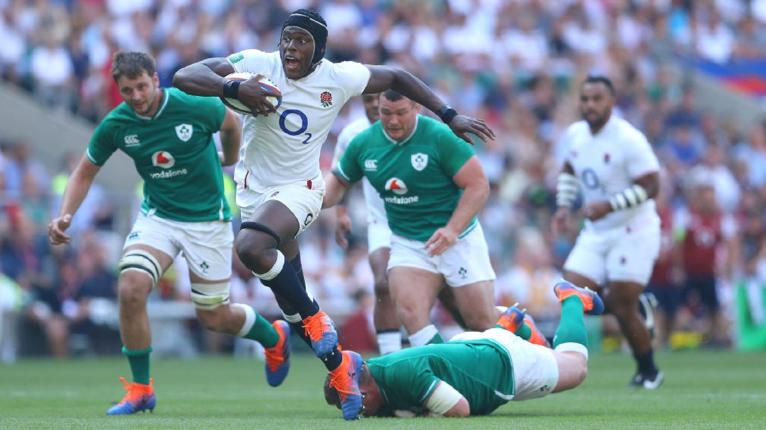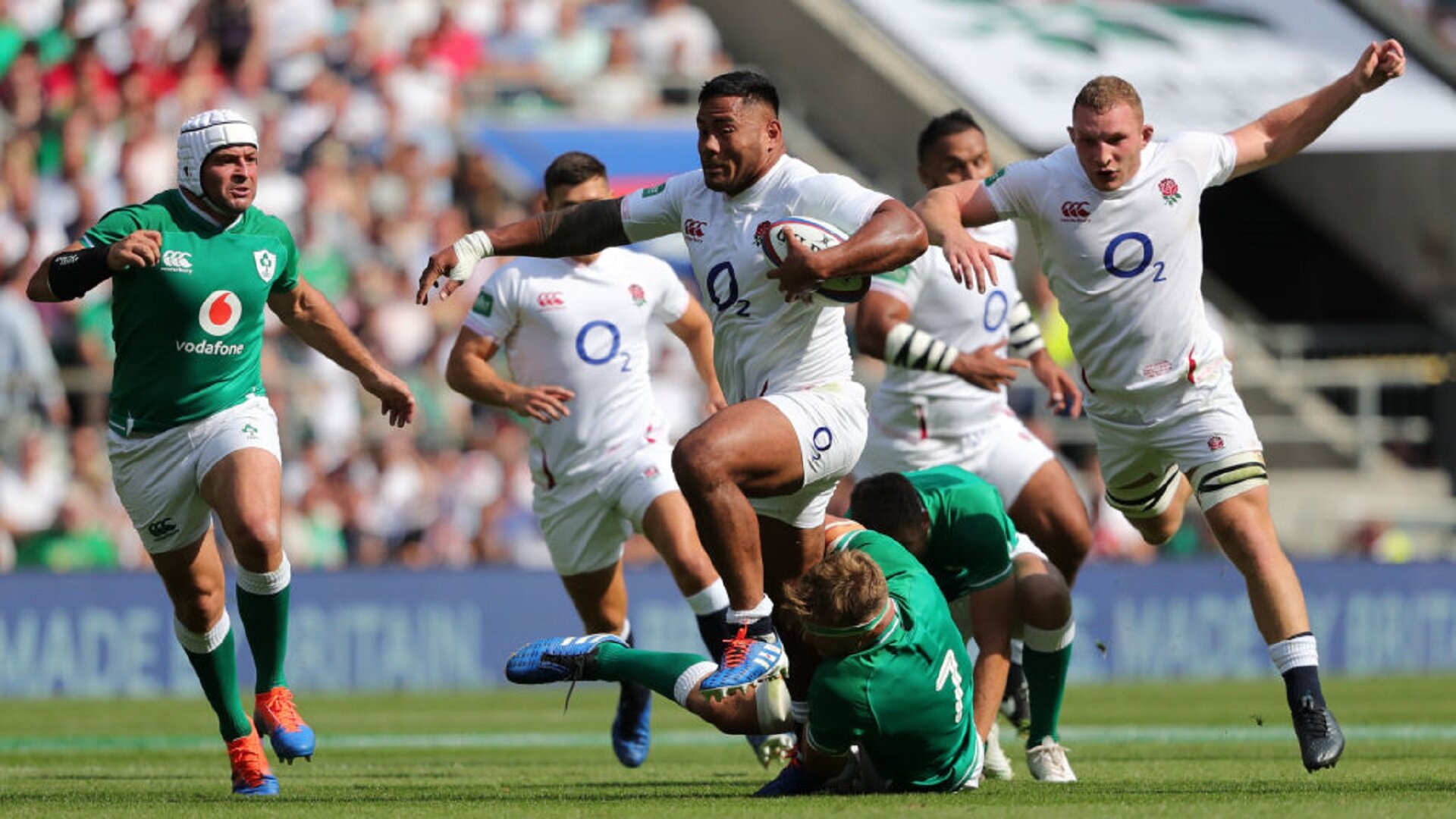Itoje and Tuilagi rise to fore in England's bid for RWC success

Any time a team puts 57 points on an opponent, there is going to be cause for optimism.
When those 57 points come against a team that is usually as disciplined, well-coached and competitive as Ireland are, that optimism is only going to be magnified.
Any feelings of discontent that might have followed England’s loss to Wales last week in Cardiff were quickly washed away on Saturday, as Eddie Jones’ side cruised to an at times stunning 57-15 victory over, on paper, a particularly strong Ireland side.
In fairness to Ireland, many of their players were playing their first Rugby World Cup warm-up game of the summer, with significant rotation in the opener against Italy. That said, the same was true of a number of England’s starting XV. Despite having played back-to-back fixtures with Wales, Owen Farrell, Ben Youngs, Joe Marler, Kyle Sinckler, Jamie George, Sam Underhill and Jonny May were all starting for the first time this summer.
As off the pace and out of sorts as Ireland looked, England were equally powerful, ruthless and disciplined, the last of which has not always been the case when these two teams have met in recent years.
On the subject of discipline, that improvement was no more evident than it was in the performance of Maro Itoje, with everything that England were able to do – and do well up front – seemingly revolved around him.
There was a period in Itoje’s still young career when the lock began to earn the ire of referees, particularly at the lineout. Whether it was the 24-year-old testing boundaries and working out what he could get away with or simply being too enthusiastic in getting his hands on the opponent and trying to disrupt throw, he had begun to become a semi-regular source of penalties.
A short blip or a worrying trend? The former, it would seem.

On Saturday, Itoje was imperious on both sides of the lineout. After Ireland had disrupted the first two English throws of the game, the first of which saw George Kruis ripped at the maul and the second he was hounded into a flapped and batted pass, George went to Itoje on five-straight throws, with the younger Saracens lock providing a watertight platform for his side.
On the defensive side of the ball, Itoje was able to get to four of Ireland’s lineouts, two of which led to turnovers in possession, whilst the other two left Ireland with scrappy and muddied possession. It was the kind of wrecking ball performance on Ireland’s lineout that Peter O’Mahony so regularly provides Joe Schmidt’s side with.
It was the effectiveness and cleanliness – Itoje went unpenalized over the 80 minutes – of this performance at the lineout that allowed England’s experiment with the combination of Tom Curry and Underhill on the flanks to succeed. Curry was successfully targeted on one throw in the second half, with the game already well and truly won, but neither he, Underhill nor Billy Vunipola are proven international lineout options. With Itoje ruling the skies at Twickenham, England were able to prosper in different areas of the pitch with their back row trio.
The flank duo’s mobility certainly showed up well, as the pair frequently led England’s kick chase alongside the likes of Itoje and May, with Underhill impressing with his ability to hunt down and make first-up tackles on Ireland’s back three players. Underhill delivered some of the best chop tackling England have seen since Joe Worsley, whilst Curry was able to prosper as a ball-carrier. Vunipola was, understandably, his usual self. Nothing to do with lineout work and/or flanker combinations is going to change his role in the side.
Crucially, though, the pack’s mobility, which had been lacking in Cardiff, was on full display at Twickenham and the potential negatives of that back row combination were entirely mitigated by the performance of Itoje. It was primarily the lock’s lineout work that did so, although his ball carrying, efforts at the contact area and defensive line speed all contributed significantly, too.
Ohhhhhhhh @maroitoje ?
Watch live now on @SkySports Main Event. #ENGvIRE #CarryThemHome pic.twitter.com/QheS4KJTVf
— England Rugby (@EnglandRugby) August 24, 2019
If Itoje’s work up front in the pack and the development of his game allowed England’s forwards to excel in their respective roles around him, then exactly the same can be said of Manu Tuilagi in the back line.
The Leicester Tiger has flashed his ability at inside centre over the last 12 months, but in his return to the 13 jersey on Saturday, he provided a potent reminder as to his potential in that position. His domineering performance at outside centre against the All Blacks in 2012 is still pored over by broadcasters.
It had looked as though his international future lay on the inside thanks to the form of Henry Slade and Jonathan Joseph in recent seasons, although the showing on Saturday – and what it meant for the players around him – may have raised some questions in Jones’ mind.

Purely as a solitary carrying option, Tuilagi had joy against the Irish defence. Whether it was the initial power of his carrying breaking the tackle, or his leg drives to make extra metres and tie in multiple defenders, Tuilagi was a constant thorn in the side of the visitors. As a result, Ireland were forced to commit men to stopping him.
As soon as the Irish defence keyed in on stopping Tuilagi in his tracks, everything else was opened up for the England back line. Whether it was his decoy line that created the space for Joe Cokanasiga’s early try or his powerful carry which swallowed up Irish defenders and allowed Elliot Daly to be released on the right wing, good things consistently happened when Tuilagi was on or even just near the ball.
George Ford’s play on the gain-line was made to look all the more effective with a threat as potent as Tuilagi waiting for the flat, delayed passes from England’s playmaker. In the second half, when Farrell stepped into first receiver more frequently, Tuilagi was again the willing option on his outside. Despite that 10-12 combination having been mothballed for a year, they looked like they had never been away as they connected with and floated around the powerful outside centre.
The 28-year-old wasn’t just a hammer, either, linking play with some deft touches and provided width when Ireland’s defence bit in and stayed too narrow, as they keyed in on Tuilagi’s more direct threat.
Of course, more potent challenges await England than the one Ireland posed on Saturday. It should be stressed, again, that this was an Ireland side playing well below their potential. As impressive as Itoje was at the lineout, Ireland were loose and profligate, the exact same of which can be said of their defence in general, much of which Tuilagi was able to exploit.
You can only play the opposition in front of you, though, and Itoje and Tuilagi did that superbly. If they can replicate that moving forward, they give Jones enviable freedom over what he wants to do with his back row and midfield combinations.
.@ManuTuilagi goes over for his 14th England try.
Watch live now on @SkySports Main Event.#ENGvIRE #CarryThemHome pic.twitter.com/CoaLxWfn02
— England Rugby (@EnglandRugby) August 24, 2019
Vunipola and Farrell have long been lauded as England’s two most vital players, whom everything else is built around, but if the win over Ireland showed anything, it was that Itoje and Tuilagi could be the crucial factors in England’s bid for success in Japan.
If Itoje’s game remains as disciplined and efficient as it looked on Saturday and Tuilagi can stay as fit and busy as he was, then England’s Rugby World Cup ambitions will be given a strong shot in the arm.
Jones’ side doesn’t lack for alternative options at lock or in the centres, but they don’t have any that can match the skill sets that these two men provide.
Watch: Eddie Jones and Owen Farrell talk to the press after their win over Ireland









































































